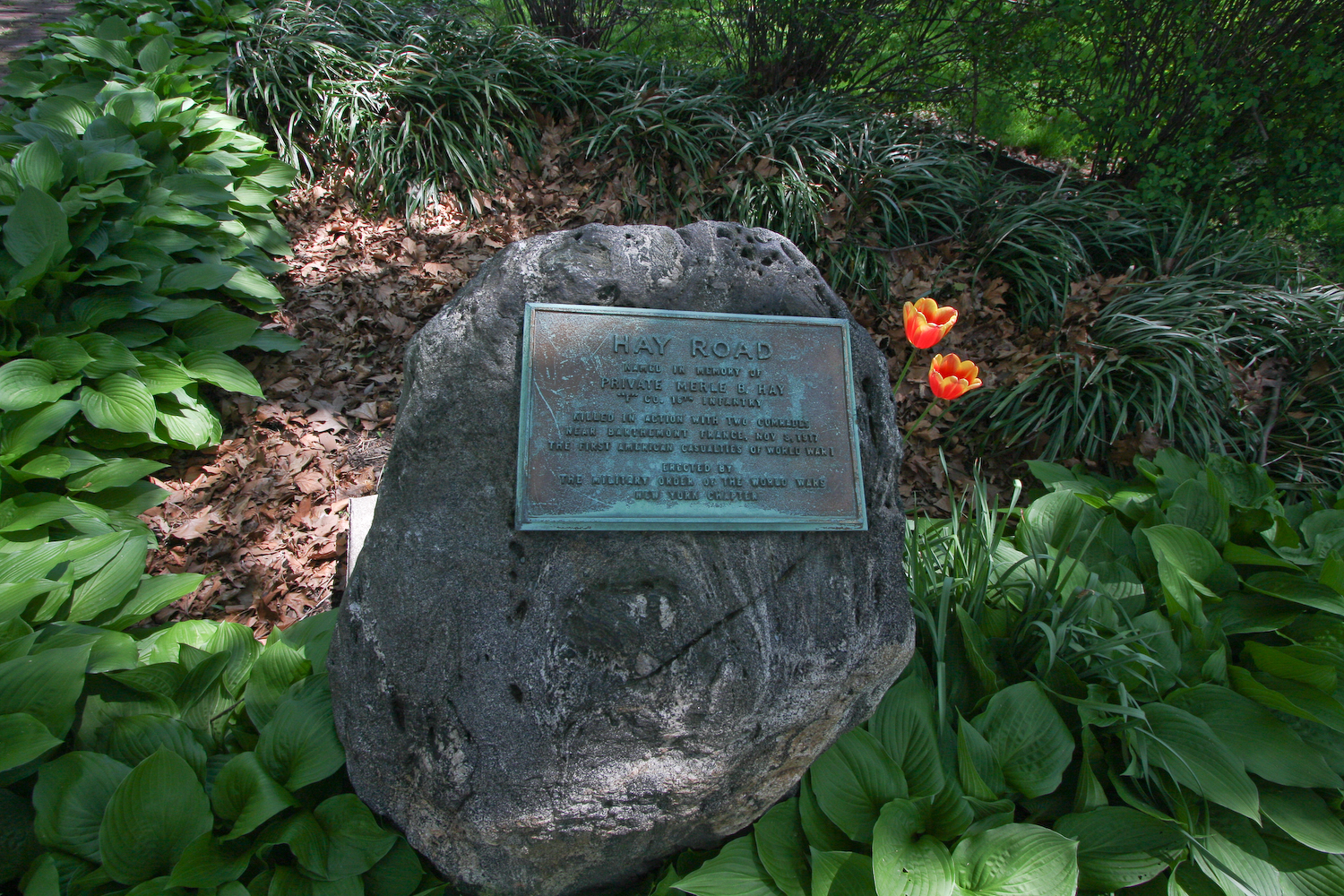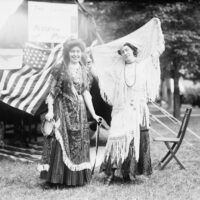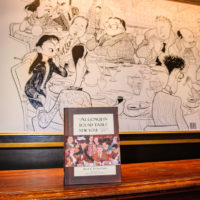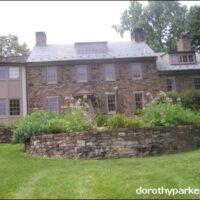Last summer I started work on a project that is small in scope but means a lot to me. Today I submitted the final grant application information to the U.S. World War I Centennial Commission for what I am calling the Governors Island World War I Memorial Project.
Last year when my book The Governors Island Explorer’s Guide was published I was not done with the island, which is by far my favorite park in the city. I started work on my next book, World War I New York: A Guide to the City’s Enduring Ties to the Great War, which comes out in about a month. I wrote a section on Governors Island, since it was so important during WWI. And as anyone who has been to Governors Island can tell you, it has a lot of bronze plaques. Some needed replacing and renovation, which is where my project started.
I met with the Trust for Governors Island, which manages the island and preserves its history. I spoke to the National Park Service, which oversees 22 acres of the National Monument. I led a site inspection by my friends from New Jersey, Peaceable Kingdom Memorials, to visit the memorials and estimate the scope of the project.
Now that the grant application is complete and the restoration and renovation can commence, here is the full outline of the project:
New York City has untold numbers of monuments and memorials spread out across its five boroughs, from the large Grant’s Tomb to the modest Balto statue. There is one public park that has the highest concentration of World War I memorials in the city: Governors Island. A military base for two hundred years, the island roads are named for soldiers killed in the Great War and there are more than twenty bronze tablets dotting its 172 acres. For the centennial of the war, this project is to restore and replace three of these tablets: two for soldiers killed in hand-to-hand combat, and one for General John J. Pershing.
Governors Island, located in New York Harbor 800 yards from Manhattan, is one of the most unique parks in the United States. In 1966 the U.S. Army left Fort Jay after tenancy that stretched back to 1800; then the U.S. Coast Guard took over the post and operated for thirty more years. In 1996 the USCG closed the base. In 2003 the U.S. turned the island back over to the people of New York. Today Governors Island functions as both a city-funded public park, and the Governors Island National Monument, twenty-two acres administered by the National Park Service (“The NPS”) since 2001. In 2016 more than 500,000 visited Governors Island, which is only open from May to September.
On Governors Island is the National Historic District, with forts, buildings, and monuments that have been designated national and state historic landmarks. It is in the boundaries of the Historic District that the majority of the WWI monuments were left by the U.S. Army. The Historic District, except for the acreage controlled by the NPS, is managed and maintained by the Trust for Governors Island (“The Trust”), a city agency that is part of the City of New York. The mandate of the Trust is to preserve and protect the historic elements dating back to the post-Colonial era left in its care.
The scope of the Governors Island World War One Memorial Project is to support the Trust by replacing two WWI memorials that have gone missing, and to restore one memorial that was damaged by a vehicle. These bronze tablets will be replaced and restored with the support and approval of the Trust.
The research, project management, and funding is being provided by Kevin C. Fitzpatrick. He is an author of two books on Governors Island history, a U.S. Marine Corps Reserve veteran, and professional project manager. The restoration and replacement of the memorials is contracted to Peaceable Kingdom Memorials of Neptune City, New Jersey; the owner’s grandfather was a WWI veteran stationed at Fort Jay as the island’s tailor.
About the Memorials
There are three components to the project. They are named:
1. Private Hay
2. Captain Kimmell
3. General Pershing
The three memorials share these characteristics:
* Cast bronze tablets
* Measure 12 inches x 8 inches
* Dedicated by the U.S. First Army (formerly headquartered on Governors Island)
* Included on numerous online databases for U.S. monuments
It is important to replace these memorials to honor the men who served our country. The boulders that the memorials were once attached to are still in their original location and condition. This cuts the cost of the project because three bases for the memorials do not need to be brought to the island. The importance of the project is that with these three missing memorials, the inventory of Governors Island World War One locations has three holes in it, places that should be filled in time for the centennial. Each of the service members was unique in his own way with a story worth remembering and honoring; currently there are only three large boulders with empty places on them.
Why Governors Island? Why a WWI project? One of the hallmarks of the government of Flanders for the centennial of the Great War is what it calls “peace tourism.” To quote:
“There is also the further objective to considerably increase peace tourism in Flanders…The First World War has left a great many visible scars upon the landscape. Aside from the numerous military cemeteries, graveyards and war memorials, there is a host of other landmarks to remind people of the events that happened during the Great War. For that reason, Flanders considers it important that relics of the War be suitably maintained and preserved. To achieve that aim, investments are made in the renovation, restoration, and maintenance of World War I sites.”
The centennial of World War I can be the impetus to make Governors Island a new destination for commemorative and peace tourism. Just like battlefield tours, cemetery visits, and national monument tourism, Governors Island could be termed the best World War I collection of memorials in New York. While it does not have a Doughboy statue–there are fifteen spread around the city–it does have more memorials for more people than any other location (excluding cemeteries).
Governors Island also has the added historical ties of the first military action in the war: On the night of April 6, 1917, minutes after the U.S. Congress declared war, soldiers from Fort Jay boarded Coast Guard and Army tugs and seized all of the German ships in the harbor. These vessels, were converted to troopships, such as USS Leviathan, to carry Doughboys to France. Governors Island was an important training post, center of General Leonard Wood’s preparedness movement, and a vital supply depot during the war. While many other locations in New York that played a part in WWI have been lost to development or time, Governors Island exists in a kind of time warp, appearing almost exactly as it was left by the Army in 1966. By adding Governors Island to the list of international WWI memorials, perhaps it will draw some of the 50 million annual visitors to New York to the island.
History and Background About the Memorials
The memorials share certain characterics that tie to First Army and are historic in nature. In 1928, for the tenth anniversary of the Armistice, the Sixteenth Infantry Regiment, headquartered at Fort Jay, set out on an ambitious memorial project of its own. The regiment named every major road for fallen members from its ranks, including the first three American Doughboys killed together in 1917 in France. One of these was Private Hay, who has a damaged memorial. The regiment named the docks, piers, and scenic locations for battles and engagements, such as Meuse-Argonne Point and Soissons Dock. General Pershing, who sailed for France from Governors Island, had a tree memorial dedicated on the centennial of his birth in 1960. That memorial is now missing, while the oak tree thrives.
This is an overview of the three memorials, their history, and their current status.
Private Hay (restoration) – Hay Road (1928)
GPS Location: 40.690909, -74.018651

War Bond Fundraising appeal.
In 1928 the 16th Infantry named this road in honor of Private Hay. A memorial bronze plaque was affixed to a boulder on the roadway post-World War II. At some point in the last five years, a vehicle struck, damaged, and knocked the memorial off its base. The Trust has the damaged tablet in its care. This memorial will be sent out for restoration and refurbishment. It will then be returned to Governors Island and replaced to its original location on Hay Road. The Hay memorial will also be used as a template for the other two missing plaques.
Captain Kimmell (replacement) – Kimmell Road (1928)
GPS Location: 40.690130, -74.012458
37 Kimmel Road, Brooklyn, NY 11231
The scenic island perimeter Kimmell Road begins at Pier 101 and runs along the water facing Red Hook, Brooklyn. It terminates at Yankee Landing. This road was dedicated in 1928 to honor Captain Harry Lispenard Kimmell, Jr., Company C, 16th Infantry Regiment, 1st Infantry Division. Captain Kimmell was born in 1895 in the District of Columbia, the son of Commander Harry L. Kimmell, Sr., an instructor at the U.S. Naval Academy. He was an appointed a midshipman in July 1914 but withdrew and joined the Army after the U.S. entered the war. Captain Kimmell earned the Distinguished Service Cross for his actions on July 19, 1918, south of Soissons, when his company was halted by machine-gun fire. He led a platoon through a heavy barrage and captured a German machine-gun nest, forcing them to surrender. His gallantry enabled the entire battalion to continue the advance. He won a second Distinguished Service Cross posthumously. He led two platoons of his company against a strongly held enemy position in the Argonne Forest. He fell mortally wounded while leading the advance, but other members of his command, inspired by his gallantry, successfully assaulted the enemy position. Captain Kimmell was killed in action near Fleville, France, on Oct. 9, 1918. Captain Kimmell was 22 years old when he died and was posthumously promoted to major. His remains were interred in Argonne American Cemetery; in 1921 they were buried in Arlington National Cemetery, Section 3, Grave 4089.
In 1928 the 16th Infantry named this road in honor of Captain Kimmell. A memorial bronze plaque was affixed to a boulder on the roadway post-World War II. At some point in the last two years the memorial has gone missing. A replica of the plaque, using older photos, will be created. It will then be returned to Governors Island and replaced to its original location on Kimmell Road. [Note: the original plaque had Captain Kimmell’s surname misspelled and incorrect date of death; these will be corrected on the replacement memorial plaque.]

Pershing Hall and the Pershing Oak.
General Pershing (replacement) – The Pershing Oak (1960)
GPS Location: 40.691661, -74.013638
A tree memorial is a living memorial. Nobody knows the history of tree memorials, but the practice gained an immense following after World War One. In the Bronx, Brooklyn, Manhattan, Queens, and Staten Island, thousands of tree memorials were dedicated to service members following the war. Regimental Grove in Central Park still exists and a few tree memorials remain nearby the Brooklyn Public Library. On Governors Island one tree memorial stands for General of the Armies, John J. Pershing, within sight of the dock he departed the U.S. in 1917 to lead the American Expeditionary Forces. The oak stands in front of Pershing Hall, built in 1934, and once the home of First Army. From this building the Army planned Operation Overlord in World War II.
In 1935, upon his 75th birthday, every French battlefield town liberated by the A.E.F. held oak tree planting ceremonies in General Pershing’s honor. It was international news when the commander in chief went back to Saint Mihiel for the tree planting. In remarks, he said that America would defend France again, “They were services we would be ready to give again if circumstances warranted.” Twenty-five years later the centennial of General Pershing’s birth was 13 September 1960. President Eisenhower proclaimed September 13 as General of the Armies John J. Pershing Centennial Day. The President called for “appropriate ceremonies designed to commemorate the life and accomplishments” of the general on the centennial of his birth in Laclede, Missouri. New York State followed suit, with a similar proclamation from Governor Nelson Rockefeller made in Albany.
The Army held a grand ceremony while planting an oak sapling tree memorial on Governors Island. Today the oak is massive, and towers perhaps 100 feet. While the A.E.F. commander has a square named in his honor on Forty-second Street in Manhattan, this 1960 tree memorial is the only living memorial for him in the city.
At some point in the last three years the bronze plaque has gone missing. A replica of the plaque, using older photos, will be created. It will then be returned to Governors Island and replaced at its original location next to the Pershing Oak.
Project Leads for Restoration
Project Leader: Kevin C. Fitzpatrick
New York, New York
Mr. Fitzpatrick has been visiting Governors Island since it opened to the public in 2003. He began leading walking tours there in 2010. Mr. Fitzpatrick is the author of The Governors Island Explorer’s Guide (Globe Pequot Press, 2016) and World War One New York: A Guide to the City’s Enduring Ties to the Great War (Globe Pequot Press, 2017). Both detail locations on Governors Island from WWI. He has written and edited five other books and is a licensed NYC sightseeing guide. Mr. Fitzpatrick has been a project manager for more than 20 years, and has worked on the staffs of MTV, the New York Times, Time Warner Cable, Pearson, and HarperCollins.
Restoration Leader: Peaceable Kingdom Memorials, Inc.
Neptune City, New Jersey
Peaceable Kingdom Memorials was established on the Jersey Shore in 1995 by Beth Duze Woolley. She had fifteen years experience in the monument industry before launching the business. Among the many memorials and monuments the company has created: National Historic Landmark plaques for the National Park Service, plaques at Monmouth Battleground State Park, the Church of the Presidents in Long Branch, President U.S. Grant memorial in Long Branch, and New Jersey’s first monument to Dr. Martin Luther King, Jr. The company has also worked on historic cemetery conservation and restoration in a dozen burial grounds in New Jersey (full list available). The company works with many regional history groups, including the Long Branch Historical Association, on local tablets and memorials. Ms. Woolley’s paternal grandparents lived on Governors Island (in a tent) during World War I when her grandfather was the post tailor.
Bronze Casting Work: Matthews Bronze
Pittsburgh, Pennsylvania
Matthews International Corporation traces its roots back to 1850 in southwestern Pennsylvania. It is an international leader in the memorial product business and has clients around the world. In 1927 Matthews pioneered the flush bronze memorial tablet, which revolutionized the cemetery industry. For more than twenty years, Matthews has been manufacturing the cast bronze inductee plaques for the National Baseball Hall of Fame and Museum in Cooperstown. Two of the company’s most famous bronze memorials are for United Airlines Flight 93 that crashed in Somerset County, Pennsylvania, on Sept. 11, 2001, and the Elvis Presley gravesite memorial at Graceland in Memphis.
Timing and Rededication
The restoration work will take place in the spring and summer 2017. The installation will be in early September 2017. The rededication will take place for all three memorials during Governors Island World War I History Weekend, Sept. 16-17, 2017. The event is free and open to the public.
For more information, follow progress on governorsislandguide.com, and Twitter @govislandguide. Hashtag: #WWIGI






